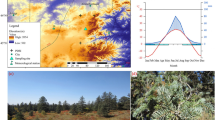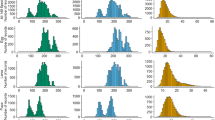Abstract
Field observations on egg hatch of Thaumetopoea processionea suggest that temporal asynchrony with Quercus robur budburst leads to starvation, retarded neonate development and mortality. However, T. processionea neonates are generally well adapted to variable between-tree and within-tree budburst phenology reflecting the species’ close bond to its host. They are able to withstand starvation periods of up to 3 weeks while searching extensively for suitable buds to feed on. Feeding and movements of young larvae frequently occur during daytime presumably taking advantage of higher day temperatures when night temperatures are below the species’ thermal threshold. Due to the specific adaptations, we assume precise temporal synchrony to play a minor role regarding its influences on T. processionea population dynamics. However, if hatching precedes budburst for more than 2–3 weeks, temporal asynchrony may become a significant mortality factor for the neonates particularly when other adverse events (e.g. unfavourable weather conditions) during that period are involved. Therefore, future studies should try to reveal further details of this interaction and focus on the impact of global warming on T. processionea—oak budburst synchronisation.




Similar content being viewed by others
References
Battisti A, Holm G, Fagrell G, Larsson S (2011) Urticating hairs in arthropods: their nature and medical significance. Annu Rev Entomol 56:203–220
Benry B, Denno RF (1997) The slow growth–high mortality hypothesis: a test using the cabbage butterfly. Ecology 78:987–999
Bergelson JM, Lawton JH (1988) Does foliage damage influence predation on the insect herbivores of birch? Ecology 69:434–445
Biliotti E (1952) Difficultés rencontrées dans la determination des périodes d’intervention contre les processionnaires du chêne et du pin. Rev Pathol Vég Entomol Agric France 31:115–120
Crawley MJ, Akhteruzzaman M (1988) Individual variation in the phenology of oak trees and its consequences for herbivorous insects. Funct Ecol 2:409–415
Custers CJL (2003) Climate change and trophic synchronisation. A case study of the oak processionary caterpillar. Master’s Thesis, Wageningen UR University
Dajoz R (2000) Insects and forests—the role and diversity of insects in the forest environment. Lavoisier, Londres
Dewar RC, Watt AD (1992) Predicted changes in the synchrony of larval emergence and budburst under climatic warming. Oecologia 89:557–559
Dissescu G, Ceianu I (1968) Cercetari asupra bioecologiei omizii processionare a stejarului (Thaumetopoea processionea L.). Centrul de documentare tehnica pentru economia forestiera, Bucuresti
Dixon AFG (2003) Climate change and phenological asynchrony. Ecol Entomol 28:380–381
Donaldson JR, Lindroth RL (2008) Effects of variable phytochemistry and budbreak phenology on defoliation of aspen during a forest tent caterpillar outbreak. Agric For Entomol 10:399–410
Feeny PP (1968a) Seasonal changes in the tannin content of oak leaves. Phytochemistry 7:871–880
Feeny PP (1968b) Effect of oak leaf tannins on larval growth of the winter moth Operophtera brumata. J Insect Physiol 14:805–817
Feeny PP (1970) Seasonal changes in oak leaf tannins and nutrients as a cause of spring feeding by winter moth caterpillars. Ecology 51:565–581
Fitzgerald TD, Peterson SC (1988) Cooperative foraging and communication in caterpillars. Bioscience 38:20–25
Forkner RE, Marquis RJ, Lill JT (2004) Feeny revisited: condensed tannins as anti-herbivore defences in leaf-chewing herbivore communities of Quercus. Ecol Entomol 29:174–187
Forkner RE, Marquis RJ, Lill JT, Le Corff J (2008) Timing is everything? Phenological synchrony and population variability in leaf-chewing herbivores of Quercus. Ecol Entomol 33:276–285
Gregor F (1957) Über die Populationsdynamik des Eichenwicklers (Tortrix viridana L.). Folia Zool 20:301–314
Grison P (1952) La processionnaire du chêne (Thaumetopoea processionea L.) dans la région parisienne. Rev Pathol Vég 31:103–114
Groenen F, Meurisse N (2012) Historical distribution of the oak processionary moth Thaumetopoea processionea in Europe suggests recolonization instead of expansion. Agric For Entomol 14:147–155
Hesmer H (1955) Die Späteiche in Westfalen und im Rheinland. Forstarchiv 26:197–203
Hoch G, Verucchi S, Schopf A (2008) Microsporidian pathogens of the oak processionary moth, Thaumetopoea processionea (L.) (Lep., Thaumetopoeidae), in eastern Austria’s oak forests. Mitt Dtsch Ges Allg Angew Ent 16:225–228
Holliday NJ (1977) Population ecology of winter moth (Operophtera brumata) on apple in relation to larval dispersal and time of bud burst. J App Ecol 14:803–813
Hunter MD (1990) Differential susceptibility to variable plant phenology and its role in competition between two insect herbivores on oak. Ecol Entomol 15:401–408
Hunter MD (1992) A variable insect–plant interaction: the relationship between tree budburst and population levels of insect herbivores among trees. Ecol Entomol 16:91–95
Hunter AF (1993) Gypsy moth population sizes and the window of opportunity in spring. Oikos 68:531–538
Hunter AF, Elkinton JS (2000) Effects of synchrony with host plant on populations of a spring-feeding Lepidopteran. Ecology 81:1248–1261
Hunter MD, Varley GC, Gradwell GR (1997) Estimating the relative roles of top-down and bottom-up forces on insect herbivore populations: a classic study revisited. Proc Natl Acad Sci USA 94:9176–9181
Jones BC, Despland E (2006) Effects of synchronization with host plant phenology occur early in the larval development of a spring folivore. Can J Zool 84:628–633
Kramer K (1996) Phenology and growth of European trees in relation to climate change. PhD Thesis, Landbouw Universiteit Wageningen
Maier H, Spiegel W, Kinaciyan T, Krehan H, Cabaj A et al (2003) The oak processionary caterpillar as the cause of an epidemic airborne disease: survey and analysis. Brit J Dermatol 149:990–997
Maksymov JK (1978) Thaumetopoeidae, Prozessionsspinner. In: Schwenke W (ed) Die Forstschädlinge Europas. 3. Band: Schmetterlinge. Paul Parey, Hamburg, pp 391–404
Meurisse N, Hoch G, Schopf A, Battisti A, Grégoire JC (2012) Low temperature tolerance and starvation ability of the oak processionary moth: implications in a context of increasing epidemics. Agric For Entomol 14:239–250
Möller K (2010) Wem schadet der Eichenprozessionsspinner—Wer muss handeln? Argumente für die aktuelle Waldschutzstrategie. Eberswalder Forstliche Schriftenreihe 44:71–81
Naef-Daenzer L, Naef-Daenzer B, Nager RG (2000) Prey selection and foraging performance of breeding great tits Parus major in relation to food availability. J Avian Biol 31:206–214
Parmesan C, Yohe G (2003) A globally coherent fingerprint of climate change impacts across natural systems. Nature 421:37–42
Parry D, Spence JR, Volney WJA (1998) Budbreak phenology and natural enemies mediate survival of first-instar forest tent caterpillar (Lepidoptera: Lasiocampidae). Environ Entomol 27:1368–1374
Pascual JA (1988) Biologia de la Processionaria del roble (Thaumetopoea processionea L.) (Lep. Thaumetopoeidae) en el centro-oeste de la Peninsula Ibérica. Bol San Veg Plagas 14:383–404
Raupp MJ, Werren JH, Sadof CF (1988) Effects of short-term phenological changes in leaf suitability on the survivorship, growth, and development of gypsy moth (Lepidoptera: Lymantriidae) larvae. Environ Entomol 17:316–319
Ronnas C, Larsson S, Pitacco A, Battisti A (2010) Effects of colony size on larval performance in a processionary moth. Ecol Entomol 35:436–445
Roversi PF (2008) Aerial spraying of Bacillus thuringiensis var. kurstaki for the Control of Thaumetopoea processionea in Turkey Oak Woods. Phytoparasitica 36:175–186
Satchell JE (1962) Resistance in oak (Quercus ssp.) to defoliation by Tortrix viridana L. in Roudsea Wood National Nature Reserve. Ann Appl Biol 50:431–442
Schaber J, Badeck F-W (2003) Physiology-based phenology models for forest tree species in Germany. Int J Biometeorol 47:193–201
Schedl KE (1936) Der Schwammspinner (Porthetria dispar L.) in Euroasien, Afrika und Nordengland. Paul Parey, Berlin
Singer MC, Parmesan C (2010) Phenological asynchrony between herbivorous insects and their hosts: signal of climate change or pre-existing adaptive strategy? Philos Trans R Soc B 365:3161–3176
Stigter H, Geraedts WHJM, Spijkers HCP (1997) Thaumetopoea processionea in the Netherlands: present status and management perspectives (Lepidoptera: Notodontidae). In: Proceedings of the Experimental and Applied Entomology, vol 8. NEV, Amsterdam, pp 3–16
Thackeray SJ, Sparks TH, Frederiksen M et al (2010) Trophic level asynchrony in rates of phenological change for marine, freshwater and terrestrial environments. Glob Change Biol 16:3304–3313
Tiberi R, Roversi PF, Bin F (1991) Egg parasitoids of pine and oak processionary caterpillars in central Italy. Redia 74(appendice): 249–250
Tikkanen O-P, Julkunen-Tiitto R (2003) Phenological variation as protection against defoliating insects: the case of Quercus robur and Operophtera brumata. Oecologia 136:244–251
Tschorsnig HP (1993) Parasitoide aus dem Eichenprozessionsspinner Thaumetopoea processionea (Linnaeus) (Lepidoptera: Thaumetopoeidae). Mitt Ent V Stuttgart 31:105–107
Van Asch M, Visser ME (2007) Phenology of forest caterpillars and their host trees: the importance of synchrony. Ann Rev Entomol 52:37–55
Van Asch M, Tienderen PH, Holleman LJM, Visser ME (2007) Predicting adaptation of phenology in response to climate change, an insect herbivore example. Glob Change Biol 13:1596–1604
Van Asch M, Julkunen-Tiitto R, Visser ME (2010) Maternal effects in an insect herbivore as a mechanism to adapt to host plant phenology. Funct Ecol 24:1103–1109
Van der Linde RJ (1971) Der Schwebeflug der jungen Raupen des Schwammspinners (Lymantria dispar L.) und der Einfluß der Nahrungspflanze auf das Entstehen desselben. J Appl Entomol 67:316–322
Van Dongen S, Backeljau T, Matthysen E, Dhont AA (1997) Synchronization of hatching date with budburst of individual host trees (Quercus robur) in the winter moth (Operophtera brumata) and its fitness consequences. J Anim Ecol 66:113–121
Varley GC, Gradwell GR (1968) Population models of the winter moth. In: Southwood TRE (ed) Insect abundance, vol 4. Symposium of the Royal Entomological Society of London, London, pp 132–142
Visser ME, Holleman LJM (2001) Warmer springs disrupt the synchrony of oak and winter moth phenology. Proc R Soc Lond B 268:289–294
Wagenhoff E, Veit H (2011) Five years of continuous Thaumetopoea processionea monitoring: tracing population dynamics in an arable landscape of south-western Germany. Gesunde Pflanzen 63:51–61
Watt AD, Woiwod IP (1999) The effect of phenological asynchrony on population dynamics: analysis of fluctuations of British Macrolepidoptera. Oikos 87:411–416
Wint W (1983) The role of alternative host plant species in the life of a polyphagous moth, Operophtera brumata (Lepidoptera: Geometridae). J Anim Ecol 52:439–450
Acknowledgments
The authors would like to thank Michael Boppré for helpful comments on previous drafts of the manuscript. We also give credit to Hansjochen Schröter for his support on conducting these studies. Furthermore, we thank Edeltrud Bruckert, Magdalena Daum, Lars Henke and Michael Kohlbrecher for their technical expertise and Luise Engel-Wagenhoff for proof-reading the English versions.
Author information
Authors and Affiliations
Corresponding author
Additional information
Communicated by A. Battisti
Rights and permissions
About this article
Cite this article
Wagenhoff, E., Blum, R., Engel, K. et al. Temporal synchrony of Thaumetopoea processionea egg hatch and Quercus robur budburst. J Pest Sci 86, 193–202 (2013). https://doi.org/10.1007/s10340-012-0457-7
Received:
Accepted:
Published:
Issue Date:
DOI: https://doi.org/10.1007/s10340-012-0457-7




